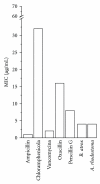Comparative analysis of viperidae venoms antibacterial profile: a short communication for proteomics
- PMID: 18955360
- PMCID: PMC3137867
- DOI: 10.1093/ecam/nen052
Comparative analysis of viperidae venoms antibacterial profile: a short communication for proteomics
Abstract
Bacterial infections involving multidrug-resistant strains are one of the ten leading causes of death and an important health problem in need for new antibacterial sources and agents. Herein, we tested and compared four snake venoms (Agkistrodon rhodostoma, Bothrops jararaca, B. atrox and Lachesis muta) against 10 Gram-positive and Gram-negative drug-resistant clinical bacteria strains to identify them as new sources of potential antibacterial molecules. Our data revealed that, as efficient as some antibiotics currently on the market (minimal inhibitory concentration (MIC) = 1-32 μg mL(-1)), A. rhodostoma and B. atrox venoms were active against Staphylococcus epidermidis and Enterococcus faecalis (MIC = 4.5 μg mL(-1)), while B. jararaca inhibited S. aureus growth (MIC = 13 μg ml(-1)). As genomic and proteomic technologies are improving and developing rapidly, our results suggested that A. rhodostoma, B. atrox and B. jararaca venoms and glands are feasible sources for searching antimicrobial prototypes for future design new antibiotics against drug-resistant clinical bacteria. They also point to an additional perspective to fully identify the pharmacological potential of these venoms by using different techniques.
Figures
Similar articles
-
Inhibition of hemorrhagic and edematogenic activities of snake venoms by a broad-spectrum protease inhibitor, murinoglobulin; the effect on venoms from five different genera in Viperidae family.Toxicon. 2003 Aug;42(2):173-81. doi: 10.1016/s0041-0101(03)00130-2. Toxicon. 2003. PMID: 12906888
-
Identification of bothrojaracin-like proteins in snake venoms from Bothrops species and Lachesis muta.Toxicon. 1999 Oct;37(10):1403-16. doi: 10.1016/s0041-0101(99)00087-2. Toxicon. 1999. PMID: 10414865
-
Identification of the Molecular Determinants of the Antibacterial Activity of LmutTX, a Lys49 Phospholipase A2 Homologue Isolated from Lachesis muta muta Snake Venom (Linnaeus, 1766).Basic Clin Pharmacol Toxicol. 2018 Apr;122(4):413-423. doi: 10.1111/bcpt.12921. Epub 2017 Dec 14. Basic Clin Pharmacol Toxicol. 2018. PMID: 29067765
-
Bothrops sp. snake venoms: comparison of some biochemical and physicochemical properties and interference in platelet functions.Comp Biochem Physiol C Pharmacol Toxicol Endocrinol. 1998 Jan;119(1):21-9. doi: 10.1016/s0742-8413(97)00163-1. Comp Biochem Physiol C Pharmacol Toxicol Endocrinol. 1998. PMID: 9580495
-
Treatment of snake bites by Bothrops species and Lachesis muta in Ecuador: laboratory screening of candidate antivenoms.Trans R Soc Trop Med Hyg. 1995 Sep-Oct;89(5):550-4. doi: 10.1016/0035-9203(95)90105-1. Trans R Soc Trop Med Hyg. 1995. PMID: 8560538
Cited by
-
Evaluation of an antimicrobial L-amino acid oxidase and peptide derivatives from Bothropoides mattogrosensis pitviper venom.PLoS One. 2012;7(3):e33639. doi: 10.1371/journal.pone.0033639. Epub 2012 Mar 16. PLoS One. 2012. PMID: 22438972 Free PMC article.
-
Predicting antibacterial activity from snake venom proteomes.PLoS One. 2020 Jan 24;15(1):e0226807. doi: 10.1371/journal.pone.0226807. eCollection 2020. PLoS One. 2020. PMID: 31978103 Free PMC article.
-
eCAM: Integrative Genomics and Fecundity.Evid Based Complement Alternat Med. 2009 Jun;6(2):129-31. doi: 10.1093/ecam/nep046. Evid Based Complement Alternat Med. 2009. PMID: 19470523 Free PMC article. No abstract available.
-
Snake Venoms in Drug Discovery: Valuable Therapeutic Tools for Life Saving.Toxins (Basel). 2019 Sep 25;11(10):564. doi: 10.3390/toxins11100564. Toxins (Basel). 2019. PMID: 31557973 Free PMC article. Review.
-
Screening Snake Venoms for Toxicity to Tetrahymena Pyriformis Revealed Anti-Protozoan Activity of Cobra Cytotoxins.Toxins (Basel). 2020 May 15;12(5):325. doi: 10.3390/toxins12050325. Toxins (Basel). 2020. PMID: 32429047 Free PMC article.
References
-
- Lopez AD, Mathers CD, Ezzati M, Jamison DT, Murray CJL. Global Burden of Disease and Risk Factors. Washington, DC, USA: IBRD/The World Bank and Oxford University Press; 2006. - PubMed
-
- World Health Organization, WHO. Department of Communicable Disease Surveillance, World Health Organization, Department of Essential Drugs and Medicines Policy, January 2007, http://www.who.int/en/
-
- Barbosa TM, Levy SB. The impact of antibiotic use on resistance development and persistence. Drug Resistance Updates. 2000;3(5):303–311. - PubMed
-
- Ang JY, Ezike E, Asmar BI. Antibacterial Resistance. Indian Journal of Pediatrics. 2004;71(3):229–239. - PubMed
LinkOut - more resources
Full Text Sources
Research Materials


